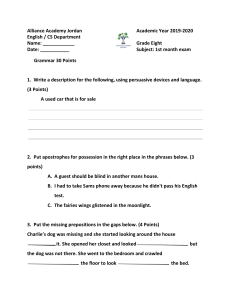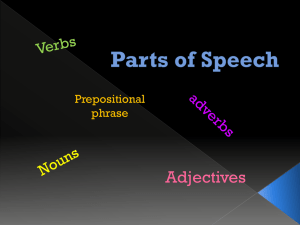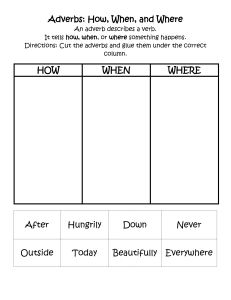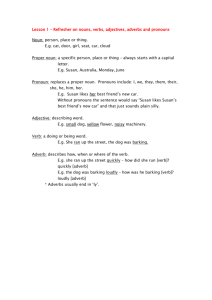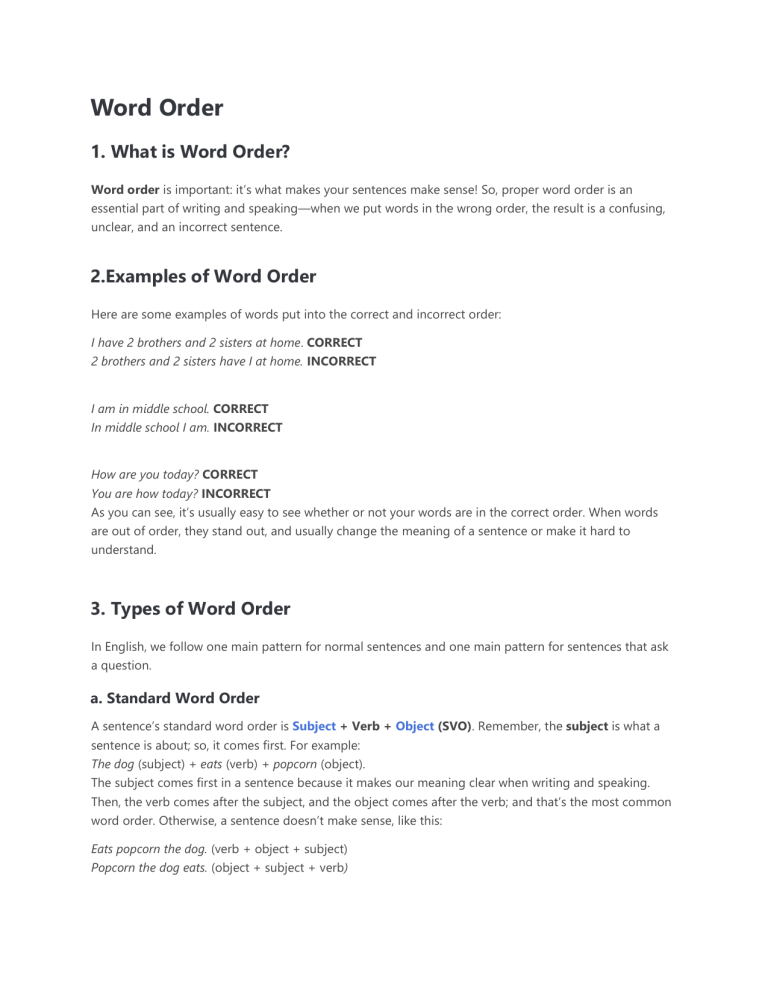
Word Order 1. What is Word Order? Word order is important: it’s what makes your sentences make sense! So, proper word order is an essential part of writing and speaking—when we put words in the wrong order, the result is a confusing, unclear, and an incorrect sentence. 2.Examples of Word Order Here are some examples of words put into the correct and incorrect order: I have 2 brothers and 2 sisters at home. CORRECT 2 brothers and 2 sisters have I at home. INCORRECT I am in middle school. CORRECT In middle school I am. INCORRECT How are you today? CORRECT You are how today? INCORRECT As you can see, it’s usually easy to see whether or not your words are in the correct order. When words are out of order, they stand out, and usually change the meaning of a sentence or make it hard to understand. 3. Types of Word Order In English, we follow one main pattern for normal sentences and one main pattern for sentences that ask a question. a. Standard Word Order A sentence’s standard word order is Subject + Verb + Object (SVO). Remember, the subject is what a sentence is about; so, it comes first. For example: The dog (subject) + eats (verb) + popcorn (object). The subject comes first in a sentence because it makes our meaning clear when writing and speaking. Then, the verb comes after the subject, and the object comes after the verb; and that’s the most common word order. Otherwise, a sentence doesn’t make sense, like this: Eats popcorn the dog. (verb + object + subject) Popcorn the dog eats. (object + subject + verb) B. Questions When asking a question, we follow the order auxiliary verb/modal auxiliary + subject + verb (ASV). Auxiliary verbs and modal auxiliaries share meaning or function, many which are forms of the verb “to be.” Auxiliary verbs can change form, but modal auxiliaries don’t. Here’s a chart to help you: As said, questions follow the form ASV; or, if they have an object, ASVO. Here are some examples: Can he cook? “Can” (auxiliary) “he” (subject) “cook” (verb) Does your dog like popcorn? “Does” (A) “your dog” (S) “like” (V) “popcorn” (O) Are you burning the popcorn? “Are” (A) “you” (S) “burning” (V) “popcorn” (O) 4. Parts of Word Order While almost sentences need to follow the basic SVO word order, we add other words, like indirect objects and modifiers, to make them more detailed. a. Indirect Objects When we add an indirect object, a sentence will follow a slightly different order. Indirect objects always come between the verb and the object, following the pattern SVIO, like this: I fed the dog some popcorn. This sentence has “I” (subject) “fed” (verb) “dog” (indirect object) “popcorn” (direct object). b. Prepositional Phrases Prepositional phrases also have special positions in sentences. When we use the prepositions like “to” or “for,” then the indirect object becomes part of a prepositional phrase, and follows the order SVOP, like this: I fed some popcorn to the dog. Other prepositional phrases, determining time and location, can go at either the beginning or the end of a sentence: He ate popcorn at the fair. -Or- In the morning I will go home. At the fair he ate popcorn. I will go home in the morning. c. Adverbs Adverbs modify verbs, adjectives, and other adverbs, adding things like time, manner, degree; and often end in ly, like “slowly,” “recently,” “nearly,” and so on. As a rule, an adverb (or any modifier) should be as close as possible to the thing it is modifying. But, adverbs are special because they can usually be placed in more than one spot in the sentence and are still correct. So, there are rules about their placement, but also many exceptions. In general, when modifying an adjective or adverb, an adverb should go before the word it modifies: The dog was extremely hungry. CORRECT adverb modifies “hungry” Extremely, the dog was hungry. INCORRECT misplaced adverb The extremely dog was hungry. INCORRECT misplaced adverb The dog was hungry extremely. INCORRECT misplaced adverb As you can see, the word “extremely” only makes sense just before the adjective “hungry.” In this situation, the adverb can only go in one place. When modifying a verb, an adverb should generally go right after the word it modifies, as in the first sentence below. BUT, these other uses are also correct, though they may not be the best: The dog ran quickly to the fair. CORRECT * BEST POSITION Quickly the dog ran to the fair. CORRECT The dog quickly ran to the fair. CORRECT The dog ran to the fair quickly. CORRECT For adverbs expressing frequency (how often something happens) the adverb goes directly after the subject: The dog always eats popcorn. He never runs slowly. I rarely see him. Adverbs expressing time (when something happens) can go at either the beginning or of the end of the sentence, depending what’s important about the sentence. If the time isn’t very important, then it goes at the beginning of the sentence, but if you want to emphasize the time, then the adverb goes at the end of the sentence: Now the dog wants popcorn. Emphasis on “the dog wants popcorn” The dog wants popcorn now. Emphasis on “now” 5. How to Use Avoid Mistakes with Word Order Aside from following the proper SVO pattern, it’s important to write and speak in the way that is the least confusing and the most clear. If you make mistakes with your word order, then your sentences won’t make sense. Basically, if a sentence is hard to understand, then it isn’t correct. Here are a few key things to remember: The subject is what a sentence is about, so it should come first. A modifier (like an adverb) should generally go as close as possible to the thing it is modifying. Indirect objects can change the word order from SVO to SVIO Prepositional phrases have special positions in sentences Finally, here’s an easy tip: when writing, always reread your sentences out loud to make sure that the words are in the proper order—it is usually pretty easy to hear! If a sentence is clear, then you should only need to read it once to understand it.
